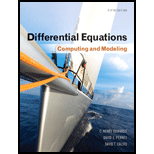
Concept explainers
Program Description: Purpose of problem is to determine whether
Explanation of Solution
Given information:
The second order differential equation is,
The value of first order differential equation at
The value of the function at
Explanation:
Consider
The characteristic equation can be expressed as follows,
The roots of the equation are as follows,
Therefore, the general solution of the differential equation can be expressed as,
Apply the initial condition in equation
Therefore, the value of
Since,
Now,consider
Then, the given differential equation can be expressed as follows,
The characteristic equation can be expressed as follows,
The roots of the equation are as follows,
Therefore, the general solution of the differential equation can be expressed as,
Differentiate the above equation with respect to
Apply the initial condition
Apply the initial condition
Therefore, the value of
Then the value of
Since,
Now,consider
Then, the given differential equation can be expressed as follows,
The characteristic equation can be expressed as follows,
The roots of the equation are as follows,
Therefore, the general solution of the differential equation can be expressed as,
Differentiate the above equation with respect to
Apply the initial condition
Apply the initial condition
Since, the value of
For all odd value
Hence, the eigenvalues for the given equation are as follows,
Conclusion:
Thus, the Eigen functions corresponding to the eigenvalues are
Want to see more full solutions like this?
Chapter 3 Solutions
Differential Equations: Computing and Modeling (5th Edition), Edwards, Penney & Calvis
- Briefly describe the issues involved in using ATM technology in Local Area Networksarrow_forwardFor this question you will perform two levels of quicksort on an array containing these numbers: 59 41 61 73 43 57 50 13 96 88 42 77 27 95 32 89 In the first blank, enter the array contents after the top level partition. In the second blank, enter the array contents after one more partition of the left-hand subarray resulting from the first partition. In the third blank, enter the array contents after one more partition of the right-hand subarray resulting from the first partition. Print the numbers with a single space between them. Use the algorithm we covered in class, in which the first element of the subarray is the partition value. Question 1 options: Blank # 1 Blank # 2 Blank # 3arrow_forward1. Transform the E-R diagram into a set of relations. Country_of Agent ID Agent H Holds Is_Reponsible_for Consignment Number $ Value May Contain Consignment Transports Container Destination Ф R Goes Off Container Number Size Vessel Voyage Registry Vessel ID Voyage_ID Tonnagearrow_forward
- I want to solve 13.2 using matlab please helparrow_forwarda) Show a possible trace of the OSPF algorithm for computing the routing table in Router 2 forthis network.b) Show the messages used by RIP to compute routing tables.arrow_forwardusing r language to answer question 4 Question 4: Obtain a 95% standard normal bootstrap confidence interval, a 95% basic bootstrap confidence interval, and a percentile confidence interval for the ρb12 in Question 3.arrow_forward
 C++ for Engineers and ScientistsComputer ScienceISBN:9781133187844Author:Bronson, Gary J.Publisher:Course Technology Ptr
C++ for Engineers and ScientistsComputer ScienceISBN:9781133187844Author:Bronson, Gary J.Publisher:Course Technology Ptr Operations Research : Applications and AlgorithmsComputer ScienceISBN:9780534380588Author:Wayne L. WinstonPublisher:Brooks Cole
Operations Research : Applications and AlgorithmsComputer ScienceISBN:9780534380588Author:Wayne L. WinstonPublisher:Brooks Cole

